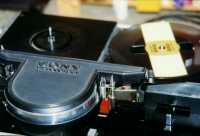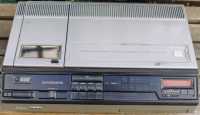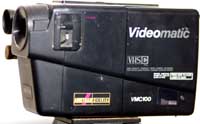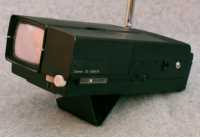 Sony introduced a half-inch, reel-to-reel,
helical scan video system in about 1964.
The system was monochrome and available in both
525-line and 625-line versions (mine is 625).
Sony introduced a half-inch, reel-to-reel,
helical scan video system in about 1964.
The system was monochrome and available in both
525-line and 625-line versions (mine is 625).
| Vintage Video |
 Sony introduced a half-inch, reel-to-reel,
helical scan video system in about 1964.
The system was monochrome and available in both
525-line and 625-line versions (mine is 625).
Sony introduced a half-inch, reel-to-reel,
helical scan video system in about 1964.
The system was monochrome and available in both
525-line and 625-line versions (mine is 625).
The model CV-2100ACE recorder is big and heavy with all the circuitry made using discrete transistors. There's no timer, tuner or RF modulator. Baseband video input and output is via UHF M-type connectors, also known as PL-259. These were the standard connectors before the smaller BNC connectors became popular, although they have now been replaced by yellow phono sockets. Fortunately, the signal carried by these plugs is unchanged and one can simply use an adaptor cable to connect the big reel-to-reel directly to a modern television set with a baseband video input, such as SCART.
Machines like this were distributed to many schools in the UK
during the 1970s, along with large-screen black and white video
monitors in big wooden cabinets.
This was an early attempt to use video as a teaching aid,
but it didn't seem to catch on until VHS arrived.
I remember the excitement of recording Concorde's first commercial
flight, in the school lunch hour, using a machine like this.
Sony introduced U-matic in 1971 with a three-quarter inch tape cassette that could record for one hour. This system became very popular with industrial and broadcasting users, and is still used today. It could record in colour, and both NTSC and PAL versions were made. The sound track is dual and could be used either as stereo or as two completely separate tracks.
My U-matic machine is a JVC top-loader in PAL format. Like the reel-to-reel, there's no timer, tuner or RF modulator and video in/out is on PL-259 sockets and quarter-inch jack sockets.
 The long-play version of the original
Philips N1500.
This machine marks the arrival of video recording as a home activity,
with the VCRs connecting to the RF signal (between aerial and TV)
and having a tuner and a timer for unattended recording.
This second-generation machine has the luxury of a digital clock for
timed operation (the first-generation N1500 had an analog clock that
looked rather like a cooker timer).
The Philips VCR format used a cassette quite unlike modern types.
The two spools of tape were arranged not side-by-side but
one above the other.
The tape took a diagonal path from lower spool to upper,
resulting in the player's head drum being vertical.
Modern VHS machines have the head drum mounted at an angle
and the tape goes straight from one spool to the other.
The long-play version of the original
Philips N1500.
This machine marks the arrival of video recording as a home activity,
with the VCRs connecting to the RF signal (between aerial and TV)
and having a tuner and a timer for unattended recording.
This second-generation machine has the luxury of a digital clock for
timed operation (the first-generation N1500 had an analog clock that
looked rather like a cooker timer).
The Philips VCR format used a cassette quite unlike modern types.
The two spools of tape were arranged not side-by-side but
one above the other.
The tape took a diagonal path from lower spool to upper,
resulting in the player's head drum being vertical.
Modern VHS machines have the head drum mounted at an angle
and the tape goes straight from one spool to the other.
Of course, no video collection is complete without a Betamax. Thanks to FreeCycle, I now have a Sony SL-C6UB complete with manual. The machine powers up OK, but the lacing mechanism fails to operate. It looks like a problem with the rubber belts that transfer the drive from the motor to the large toothed ring that pulls the tape around the head drum. I'll try to get a set of new belts and get it going again.
Perhaps the ultimate Betamax machine is the Betastack, a sort of autochanger for video tapes that fitted on top of one of the more sophisticated Sony players.

The new, innovative and doomed video format from Philips. Tapes could record four hours on each side, i.e. eight hours in all. I have a few of the older VR2020 generation, in various states of non-function. One of them has the optional extra remote control, which comprised an infra-red receiver, a decoder box and the control itself. I usually use the newer VR2324 model (actually badged by Pye as a 23VR24), which is new enough to have a SCART socket on the back. Lots of info on Video 2000 (and Betamax and U-matic, too) at PALsite.
 Introduced in the early 1980s,
this forgotten video cassette system is based on a tiny
quarter-inch tape format.
It's often referred to as “Funai/Technicolor CVC”, presumably because those
are the two companies that developed it.
It was designed for use as a portable video system with
a camera, rather like a modern camcorder.
In fact, it was intended as a replacement for 8mm home movies,
also known as Super-8.
Introduced in the early 1980s,
this forgotten video cassette system is based on a tiny
quarter-inch tape format.
It's often referred to as “Funai/Technicolor CVC”, presumably because those
are the two companies that developed it.
It was designed for use as a portable video system with
a camera, rather like a modern camcorder.
In fact, it was intended as a replacement for 8mm home movies,
also known as Super-8.
It came with a video camera, a JVC model GX-44E. This has a vidicon tube, unlike a modern CCD camera. The vidicon can't produce a picture in poor light, which rather limits its usefulness as a home movie system. Perhaps people were able to accept this limitation due to the similar limitations of slow film in Super-8 cameras. Unlike a camcorder or film camera, the video cassette recorder is in a separate unit, worn over the shoulder with a strap. The recorder unit also contains the battery pack. On the front of the recorder is a row of five “piano-key” controls (in silver) that operate the machine mechanically.
I have the recorder (it's a PAL version for the UK), camera and power supply but I do not have the add-on accessory tuner for recording broadcast TV. The machine has a large pack of NiCads to power it when recording. Unfortunately, I have only one tape. The tape has the initials CVC on it, standing for Compact Video Cassette.
Technicolor 212E at Total Rewind
 VHS-C, or Compact VHS, was introduced solely for use in camcorders.
It uses the same tape and tape format as VHS, but in a much smaller cassette,
which only contains enough tape for 30 minutes recording (60 minutes in long-play mode).
The VHS-C cassette is then inserted into a special holder, the same size and shape as
a full-size VHS cassette, and played back in a normal VHS player.
VHS-C, or Compact VHS, was introduced solely for use in camcorders.
It uses the same tape and tape format as VHS, but in a much smaller cassette,
which only contains enough tape for 30 minutes recording (60 minutes in long-play mode).
The VHS-C cassette is then inserted into a special holder, the same size and shape as
a full-size VHS cassette, and played back in a normal VHS player.
The Amstrad VMC100, introduced in 1988, is a very basic (and very cheap) camcorder. It has no zoom lens, no focusing, no playback capability and a simple optical viewfinder. It can't even rewind the VHS-C cassette (you have to use the adaptor and the full-size VHS machine for that). It does have a switch for SP/LP mode, and a white-balance switch. Most of the bulk of the camcorder is taken up by the cassette mechanism, with just the front section containing all the electronics (maybe 20% of the total length).
 CED stands for Capacitance Electronic Disk, an RCA invention.
The disk is housed in a rigid plastic sleeve that the player unlocks
and removes.
Quite a few of the disks are music videos, perhaps due
to the availability of stereo sound in this format.
I have a copy of Das Boot on CED format video disk.
CED Magic.
CED stands for Capacitance Electronic Disk, an RCA invention.
The disk is housed in a rigid plastic sleeve that the player unlocks
and removes.
Quite a few of the disks are music videos, perhaps due
to the availability of stereo sound in this format.
I have a copy of Das Boot on CED format video disk.
CED Magic.

Huge, thick and heavy disks, silvered like a CD but holding an analog video signal. Each side of a disk could hold about an hour of video, so feature films require a pause in the middle to flip the disk over. Some films are on two disks. Again, a stereo sound track is available, and sometimes even a dual mono arrangement with different audio content on the two channels. I have several examples of video disk players, starting with the original Philips VLP600. My newest model is a Pioneer CLD-S310S, which is the only model I have that's capable of playing the newer, digital soundtrack disks.

The original Sinclair pocket TV was a multi-standard set, designed to work on most of the TV systems in the world. It was marketed as the ideal thing for world travellers to take with them and watch wherever they went. This example is the later, UK-only version. It has, of course, far fewer controls and was sold as a straightforward portable TV. The tube is fairly conventional, although it uses electrostatic deflection rather than the usual (for TV) magnetic deflection. The same tube was used by the Sinclair instrument division (later known as Thandar) in a portable oscilloscope.

The last of the Sinclair pocket TVs was the FTV-1, the flat-screen model. It has a very novel CRT which reduces the thickness of the TV dramatically. It fires the electron beam from one side (right, when the TV is held normally) and deflects it to strike the phosphor screen from the front. The resulting picture is distorted, so there are two ingenious correcting mechnisms. One is an electronic scanning system that corrects for distortions within the CRT, while the other is an anamorphic lens that corrects the aspect ratio of the image. The rest of the electronics has been reduced to little more than a single chip, although the parts are not so small that they are surface-mounted, as in a modern device. Even the battery is novel, being a thin, flat 6-volt battery made by Polaroid. It was designed to go inside Polaroid instant film packs, but is no longer obtainable as a replacement for the TV.
This is a fairly modern personal TV with AM/FM radio. It has room in the base for ten “D” size cells if you want to power it from batteries. Unlike some types of tiny TV, this one has sockets on the back for video and audio input. I have a plan to use this as a monitor with some of my classic computers, where the low resolution of the computer's display will be quite acceptable on a small CRT.
Return to the Old Sad Things page
Return to John Honniball's home page
Copyright © 1998-2011 by John Honniball. All rights reserved.